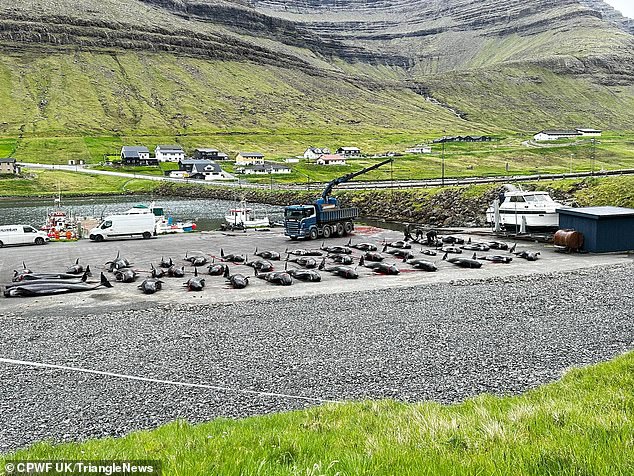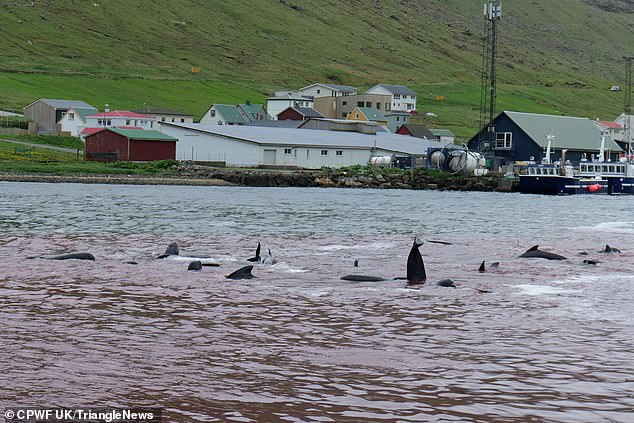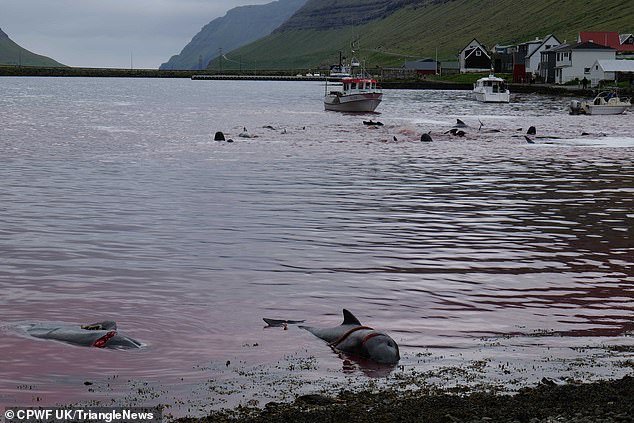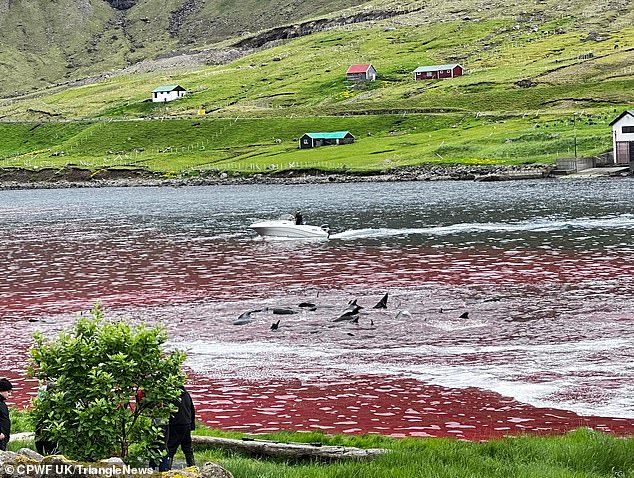At least 138 pilot whales died in the latest grindadrap in the Faroe Islands, a gruesome Viking tradition in which animals are rounded up and hacked to death.
The sea was stained red with the animals’ blood when they were cut and stabbed after being held in an inescapable part of the port of Hvannasund, a town on the west coast of Viðoy, the northernmost island of the archipelago.
‘Grindadrap’, or ‘grind’ for short, is a 1,000-year-old Faroese tradition in which hunters surround pilot whales and dolphins with their fishing boats and drive them into a shallow bay.
The terrified animals are stranded and the fishermen brutally kill them with knives on the shore, and the locals then eat their meat and fat.
Every summer, shocking images of the bloody hunt show the macabre ritual, which is strongly condemned by outraged animal rights activists who consider the practice barbaric.
The water turned red with the animals’ blood as they were cut and stabbed after being held in an inescapable part of the port of Hvannasund, a town on the west coast of Viðoy.

Pilot whales are lying on the ground after being slaughtered during the Grindadrap.
This year, witnesses from marine wildlife charity the Captain Paul Watson Foundation said the trip was particularly shocking because of the length of time the animals suffered.
On Saturday, around 11.30am local time, a Faroese fishing patrol boat spotted a pod initially estimated to be between 50 and 100 long-finned pilot whales off Viðoy.
At 12:45 the decision was made to take them there and over the next few hours the capsule was slowly pushed towards land.
Witnesses said the number of ships involved was smaller than usual, probably due to an ongoing strike in the Faroe Islands that has caused a major fuel shortage.
Shortly after 3pm it was confirmed that the animals would be driven out to be killed at 4pm, however this time came and went and the animals were still being held on boats inside a fjord.
It was then announced that the slaughter would be delayed to allow the rowing competition in Klaksvik to finish and for more people to be present on the beach to watch the animals die.
Two and a half hours later, the boats finally took away the dolphins, who had already been in a stressful situation for more than five and a half hours.
Disturbing video shows the animals moving their heads over the red water to see what was happening.
A spokesperson for the foundation said: “Our livestream footage shows the animals fighting on shore for more than 25 minutes while other members of the group were killed, after which the boats kept the remaining animals alive for another few minutes. 90 minutes while they fought.” on the rocky coast and was showing increasing signs of stress.
«In the end the decision was made to expel the remaining animals into the sea.

Disturbing video shows the animals moving their heads over the red water to see what was happening.
“These efforts appeared to be less enthusiastic than when they were led in, with one individual throwing rocks at the capsule while a single ship maneuvered around it.
‘The designated killing area was different from the one usually used in Hvannasund, possibly due to the low tide.
“This meant that the animals were driven ashore on large rocks, while the other part of the killing area was a concrete wall, making it difficult to insert the hook into the blow hole and then pull them in to paralyze and kill them. “.
Initial counts indicate that at least 40 long-finned pilot whales were killed in the first batch, and the charity says there is no humane way to accomplish such a task.
Later, many of the remaining animals appear to be stranded and killed, with the death toll at 138 as of Sunday night.
Rob Read, chief operating officer of the UK’s Paul Watson Foundation, said: “The Faroese use the close kinship ties between pilot whales against them and, although it is a relief that some animals have been saved today, the event of today will require an enormous effort.” price for this family group.
“It would not be a surprise if more animals died as a direct result of today’s grindadráp, whether from injuries sustained by boats and rocks, or from the sheer stress of today’s events.”

Pilot whales with visible cuts are seen on the coast while members of their pod continue to be mocked in the background.
Long-finned pilot whales are actually dolphins and are famous for their close-knit family groups headed by an elderly matriarch.
Reproduction and mating usually take place between April and September and a single calf is born every three to six years.
Older, non-reproductive females help care for the herd’s young.
Female long-finned pilot whales can live up to 60 years, while males can live up to 45 years.
Like all cetaceans (whales, dolphins and porpoises), long-finned pilot whales play a vital role in ocean ecosystems, helping to keep them alive and thriving.
Volunteers have been pushing to end this routine, which kills hundreds of whales each year.
The Faroese claim that this is part of their tradition and that hunting provides free food for their community.
But activist groups call the hunt, which takes place every year, “barbaric” and say it is no longer just about feeding the islanders, selling excess meat and fat.
Fishermen typically surround the animals before beaching and dismembering them, often turning the sea red with their blood, with aerial shots showing blood-stained water during the 2023 routine.
As of July last year, 648 pilot whales had died in the cull, which has been widely condemned by charities and animal lovers.
The Faroe Islands are an autonomous archipelago that is part of the Kingdom of Denmark in the North Atlantic between Norway and Iceland.

